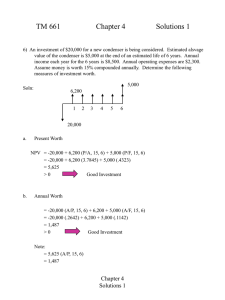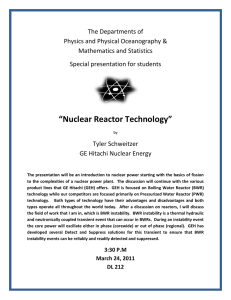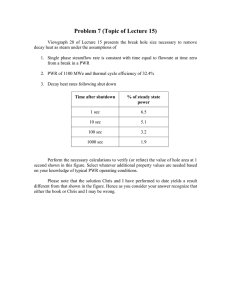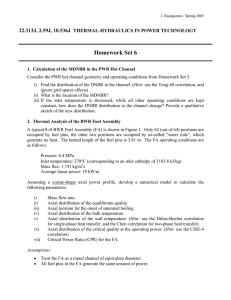Two-phase flow and boiling heat transfer - Fall 2010 Problem Set 7 22.06
advertisement
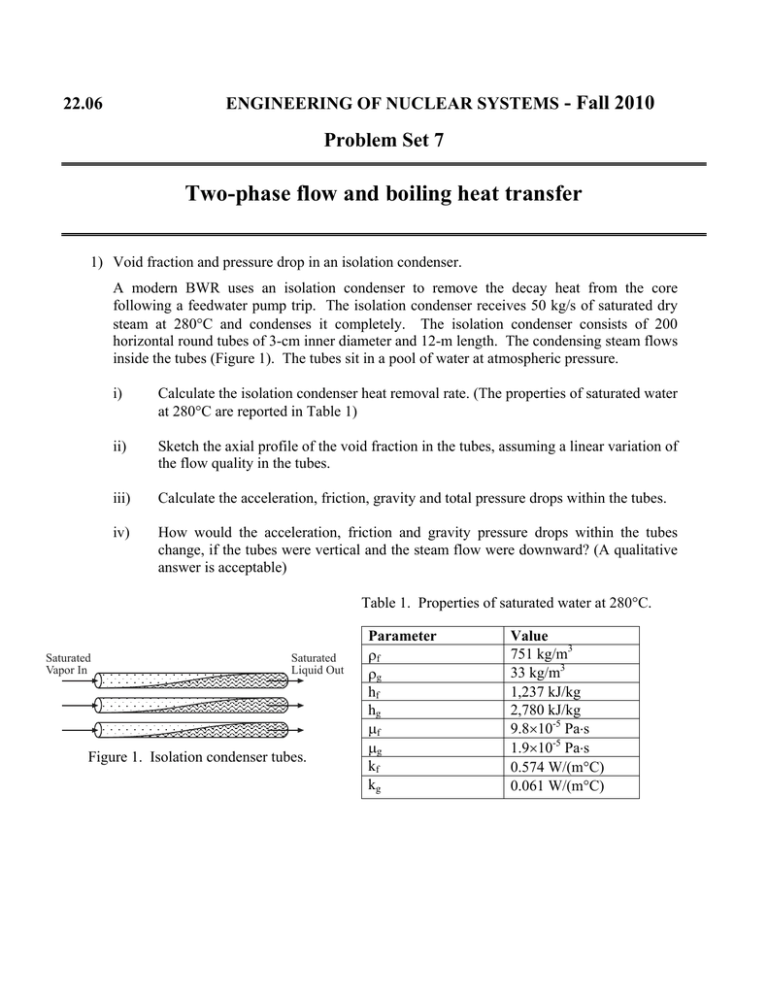
ENGINEERING OF NUCLEAR SYSTEMS - Fall 2010 22.06 Problem Set 7 Two-phase flow and boiling heat transfer 1) Void fraction and pressure drop in an isolation condenser. A modern BWR uses an isolation condenser to remove the decay heat from the core following a feedwater pump trip. The isolation condenser receives 50 kg/s of saturated dry steam at 280C and condenses it completely. The isolation condenser consists of 200 horizontal round tubes of 3-cm inner diameter and 12-m length. The condensing steam flows inside the tubes (Figure 1). The tubes sit in a pool of water at atmospheric pressure. i) Calculate the isolation condenser heat removal rate. (The properties of saturated water at 280C are reported in Table 1) ii) Sketch the axial profile of the void fraction in the tubes, assuming a linear variation of the flow quality in the tubes. iii) Calculate the acceleration, friction, gravity and total pressure drops within the tubes. iv) How would the acceleration, friction and gravity pressure drops within the tubes change, if the tubes were vertical and the steam flow were downward? (A qualitative answer is acceptable) Table 1. Properties of saturated water at 280C. Saturated Vapor In Saturated Liquid Out Figure 1. Isolation condenser tubes. Parameter f g hf hg f g kf kg Value 751 kg/m3 33 kg/m3 1,237 kJ/kg 2,780 kJ/kg 9.810-5 Pas 1.910-5 Pas 0.574 W/(mC) 0.061 W/(mC) 2) Define (two sentences max) the following two-phase flow and heat transfer terms, and mark if the associated phenomena occur at normal operating conditions in the PWR core, BWR core, or both. Flow boiling …………………………………………………………………………………. …………………………………………………………………………………………………….. PWR…. BWR…. Subcooled boiling…………………………………………………………………………………. …………………………………………………………………………………………………….. PWR…. BWR…. Nucleate boiling…………………………………………………………………………………. …………………………………………………………………………………………………….. PWR…. BWR…. Film boiling…………………………………………………………………………………. …………………………………………………………………………………………………….. PWR…. BWR…. Pool boiling…………………………………………………………………………………. …………………………………………………………………………………………………….. PWR…. BWR…. Departure from nucleate boiling (DNB) ……………………………………………………….. ………………………………………. ……………………………………………………………. PWR…. BWR…. Dryout…………………………………………………………………………………. …………………………………………………………………………………………………….. PWR…. BWR…. 3) Departure from Nucleate Boiling in a PWR The departure from nucleate boiling (DNB) heat flux and the operating heat flux in the hot channel of a PWR at 100% power are sketched qualitatively in Figure 2, as functions of the axial location, z. If the reactor power were increased (without changing the mass flow rate, pressure and inlet temperature), how would the curves of Figure 2 change? Heat flux q″DNB (100% power) q″ (100% power) 0 L z Figure 2. Axial variation of the DNB and operating heat fluxes in the PWR hot channel. 4) Loss Of Flow Accident (LOFA) in a fast-spectrum BWR. To achieve a fast neutron spectrum in a boiling water reactor, a nuclear engineer is analyzing a concept with short fuel assemblies and a tight fuel pin pitch. First consider the nominal operation of one of these fuel assemblies. The hydraulic diameter of the fuel assembly is 0.01 m, the flow area is 0.005 m2 and the length is 2.5 m. The operating pressure is 6.4 MPa. The inlet temperature is 260C, and the outlet flow quality is 0.3. The fuel assembly power is 6 MW. The heat flux can be considered axially uniform. i) Calculate the mass flow rate in the fuel assembly. (Assume constant specific heat in the subcooled region) ii) Calculate the critical quality at the fuel assembly outlet. (Use the CISE-4 correlation and assume Pw=Ph) iii) Due to malfunction of one of the recirculation pumps, the flow in the fuel assembly suddenly drops and stabilizes at 50% of its nominal value, while the power, pressure and inlet temperature remain constant. Does the critical quality at the outlet increase or decrease? Does dryout occur? iv) Qualitatively describe the dominant heat transfer mechanisms at the fuel assembly outlet at the nominal conditions and at the reduced-flow conditions. v) Consider each term of the momentum equation (i.e., acceleration, friction, form and gravity pressure drop) and describe the effect that could cause that term to increase or decrease as a result of the flow reduction. If there are two or more conflicting effects, list them and identify which one is likely to be dominant. Provide a qualitative answer. Table 2. Properties of saturated water at 6.4 MPa Parameter Tsat f g hf hg Cp,f Cp,g f g kf kg Value 279.8C 751 kg/m3 33 kg/m3 1,236 kJ/kg 2,780 kJ/kg 5.3 kJ/(kgC) 5.0 kJ/(kgC) 9.810-5 Pas 1.910-5 Pas 0.574 W/(mC) 0.061 W/(mC) 0.019 N/m MIT OpenCourseWare http://ocw.mit.edu 22.06 Engineering of Nuclear Systems Fall 2010 For information about citing these materials or our Terms of Use, visit: http://ocw.mit.edu/terms.
